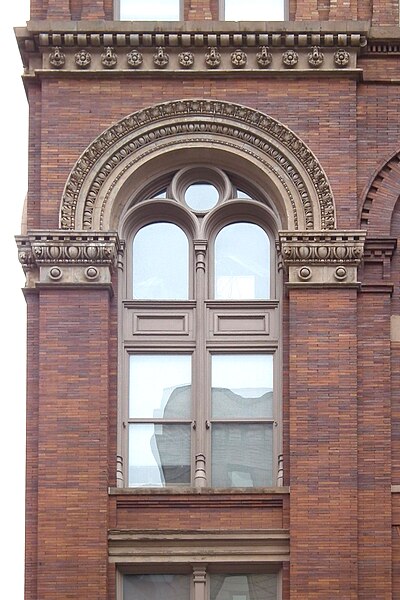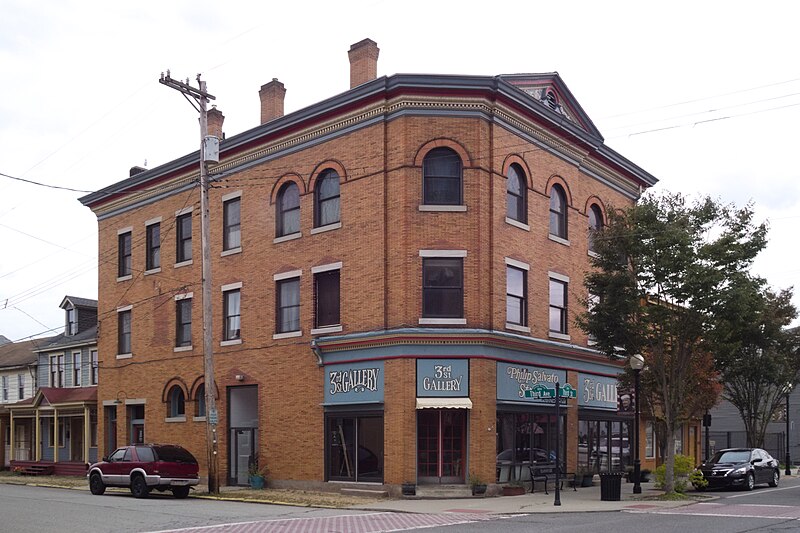
George S. Orth was the architect of this palace of education, which was finished in 1894. It’s a little bit Flemish Renaissance, with eye-catching horizontal stripes and Rundbogenstil eyebrows over the arches.



These are what old Pa Pitt calls Baltimore-style rowhouses: that is, rowhouses where the whole row is built as one subdivided building right against the sidewalk (as opposed to the typical Pittsburgh terrace, where the houses are set back with tiny front yards). Since North Avenue is the neighborhood boundary on city planning maps, these fall into the “Central Northside” for planning purposes; but socially they formed part of the wealthy section of Allegheny that includes Allegheny West across the street.


Now the Keystone Flats apartments, this building was put up in the 1890s, and that is about all old Pa Pitt knows about it. It’s a good example of the Rundbogenstil, straddling the line between Romanesque and Renaissance.
In most cities, Third Avenue would be called an alley, so it is nearly impossible to get a picture like this. It cannot be done without a lot of fudging, so you will notice slightly different colors in different parts of the picture. But it does give us a good idea of the design.

The Boulevard of the Allies side of one of the side-by-side Hartje Brothers buildings. Charles Bickel designed this building and the matching one behind it on Wood Street. This was the later of the two, both built in 1902 for the Hartje Brothers Paper Manufacturing Company. Mr. Bickel was extraordinarily prolific, but old Pa Pitt thinks he deserved his success. For an interesting comparison, look at the Reymer Brothers candy factory and the Concordia Club, and see how Charles Bickel created different effects from the same basic shapes.


The Masonic Hall in Carnegie is a fine example of small-town Rundbogenstil, taking its details from Renaissance architecture and its rhythm from industrial Romanesque.

If Father Pitt owned this building and had to put up with those two modern blisters on top, he would have them painted to look like cat ears.

The goat ornaments were doubtless intended to reassure the Masons’ neighbors that Masonry has no satanic connotations at all.

Father Pitt took these pictures more than a year ago, but for some reason he never published them until now. This Rundbogenstil building at Third Street and Third Avenue takes full advantage of its corner site, and the details of the pediment and cornice have been lovingly picked out in tastefully balanced colors.



The ground floor of this building has been turned into a garage, but without losing too much of the character of the façade. The date stone tells us that the building was put up in 1889.

Probably a little later, but not too much later, a building went up to the left of this one, perhaps for the same owners.

This building appears on a 1906 map, which gives us a latest possible date. The style is somewhat different—we might call it Allegheny Valley Rundbogenstil—but the two buildings share some decorative details: the treatment of the cornice is the same, and the same flower-and-foliage ornaments (they look like a jonquil between acanthus leaves) are used on both buildings.



Several synagogues in Pittsburgh have been adapted from private houses—one of them half a block away from here. This one seems no longer to be a synagogue, so it has gone from residential to institutional to residential again. The inscription is mostly in Hebrew, which old Pa Pitt regrets that he does not read, so perhaps a reader can inform us which congregation was here. The English part of the inscription memorializes Mr. & Mrs. Bennie Fineberg, perhaps the donors.
We could try to imagine what the front of this house looked like before its conversion. But we needn’t put in the effort, because a nearly identical house is right next door:

This one has been converted to apartments, and it has suffered some alterations, but nothing that takes very much imagination to remove in our mind’s eye and restore the original look of the house.

This building probably dates from the 1890s, and it looks from the style as though the well-preserved painted sign may date from the same era.

The building still belongs to a kind of bank and is kept in good shape, though its ground floor was unfortunately modernized back when that seemed like a good idea.


On the back, facing traffic coming down the hill from Noblestown Road, was another sign advertising the West End Savings Bank & Trust Co., but it was later painted over with an advertisement for Heselbarths Real Estate—Insurance.